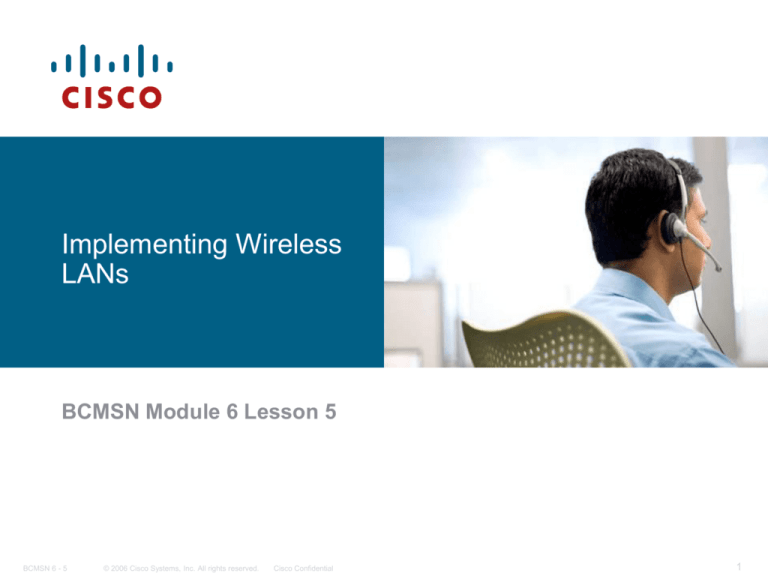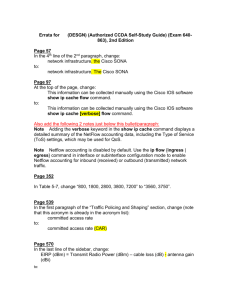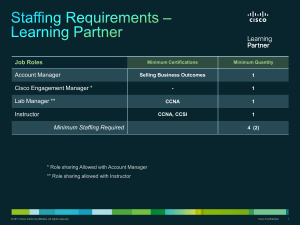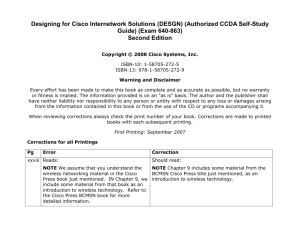
Implementing Wireless
LANs
BCMSN Module 6 Lesson 5
BCMSN 6 - 5
© 2006 Cisco Systems, Inc. All rights reserved.
Cisco Confidential
1
Objectives
Describe the implementation of the Cisco autonomous and
lightweight WLAN solution that is part of the Cisco implementation
of WLANs
Describe how LWAPP is used in the Cisco lightweight WLAN
implementation
Describe the components of the Cisco WLAN implementations
Describe Cisco Unified Wireless Networks
Describe Cisco Aironet access points and bridges
Describe PoE for access points and IP phones
Identify the types of antennas to use in WLAN environments
Explain multipath distortion
Describe the decibel calculation
Explain the established EIRP guidelines
BCMSN 6 - 5
© 2006 Cisco Systems, Inc. All rights reserved.
Cisco Confidential
2
Cisco WLAN Implementation
Cisco offers 2 “flavors” of wireless solutions:
Distributed WLAN solution
Autonomous AP
Wireless LAN Solution Engine (WLSE)
Centralized WLAN solution
Lightweight AP
Wireless LAN Controller (WLC)
BCMSN 6 - 5
© 2006 Cisco Systems, Inc. All rights reserved.
Cisco Confidential
3
Distributed WLAN Solution Components
Autonomous access points
Network Infrastructure
Wireless Domain Services
(WDS) – optional
Wireless LAN Solution
Engine (WLSE) – optional
Acess Control Server
(ACS) – optional
BCMSN 6 - 5
© 2006 Cisco Systems, Inc. All rights reserved.
Cisco Confidential
4
Centralized WLAN Solution Components
Lightweight access points
Network Infrastructure
Wireless LAN controller
(WLC) – required
Wireless Control System
(WCS) – optional
Location appliance –
optional
Acess Control Server
(ACS) – optional
BCMSN 6 - 5
© 2006 Cisco Systems, Inc. All rights reserved.
Cisco Confidential
5
Cisco Centralized WLAN Model
BCMSN 6 - 5
© 2006 Cisco Systems, Inc. All rights reserved.
Cisco Confidential
6
Why Lightweight APs?
A WLAN controller system is used to create and
enforce policies across many different lightweight
access points.
With centralized intelligence, functions essential to
WLAN operations such as security, mobility, and quality
of service (QoS), can be efficiently managed across an
entire wireless enterprise.
Splitting functions between
the access point and the
controller, simplifies
management, improves
performance, and increases
security of large WLANs
BCMSN 6 - 5
© 2006 Cisco Systems, Inc. All rights reserved.
Cisco Confidential
7
Wireless LAN Solution Comparison
Centralized
Solution
Distributed Solution
Autonomous
access points
Lightweight access
points
Wireless Domain
Services (WDS)
WLAN controller
WLAN Solution
Engine (WLSE)
WLAN Control
System (WCS)
PoE switches,
routers
PoE switches,
routers
DHCP, DNS, AAA
DHCP, DNS, AAA
BCMSN 6 - 5
© 2006 Cisco Systems, Inc. All rights reserved.
Cisco Confidential
8
Self Check
1. What is the primary difference between the distributed
and centralized solutions offered by Cisco for
WLANs?
2. Which solution uses autonomous access points and a
Wireless LAN Solutions Engine?
3. What types of functions are handled by the AP in the
Centralized model?
BCMSN 6 - 5
© 2006 Cisco Systems, Inc. All rights reserved.
Cisco Confidential
9
LWAPP
BCMSN 6 - 5
© 2006 Cisco Systems, Inc. All rights reserved.
Cisco Confidential
10
Layer-2 LWAPP Architecture
Access Points don’t require IP addressing
Controllers need to be on EVERY subnet on which APs reside
L2 LWAPP was the first step in the evolution of the architecture;
many current products do not support this functionality
BCMSN 6 - 5
© 2006 Cisco Systems, Inc. All rights reserved.
Cisco Confidential
11
Layer-3 LWAPP Architecture
Access Points require IP addressing
APs can communicate w/ WLC across routed boundaries
L3 LWAPP is more flexible than L2 LWAPP and all products
support this LWAPP operational ‘flavor’
BCMSN 6 - 5
© 2006 Cisco Systems, Inc. All rights reserved.
Cisco Confidential
12
Association of Access Point to WLAN
Controller
Access points use LWAPP in Layer 2 and Layer 3 mode
to associate to the WLAN controller.
In Layer 3 mode, the access point sends an LWAPP
Discovery Request to the controller management IP
address via a directed broadcast.
The controller responds with a Discovery Response
from the manager IP address that includes the number
of access points currently associated to the access
point manager interface.
The access point chooses an access point and sends
the Join Request.
All subsequent communication is to the WLAN
controller access point manager IP address.
BCMSN 6 - 5
© 2006 Cisco Systems, Inc. All rights reserved.
Cisco Confidential
13
LWAPP Controller Discovery
LWAPP Discovery Request—AP issues 1 or more of these
messages to find controllers (sent to Management Interface IP
Address)
LWAPP Discovery Response—Any controller receiving an LWAPP
Discovery Request responds with this message to the requesting
AP
BCMSN 6 - 5
© 2006 Cisco Systems, Inc. All rights reserved.
Cisco Confidential
14
WLAN Controller Selection Algorithm
LWAPP Discovery Response contains important
information from the WLAN Controller:
Controller sysName, controller type, controller AP capacity, current AP load,
“Master Controller” status, AP Manager IP address(es) and number of APs
joined to the AP Manager
After an “LWAPP Discovery Interval” timer expires, the
AP selects a controller to join using the following
decision criteria:
1. If AP has been previously configured with a primary, secondary, and/or
tertiary controller, the AP will attempt to join these first (specified in the
Controller sysName)
2. Attempt to join a WLAN Controller configured as a “Master” controller
3. Attempt to join the WLAN Controller with the greatest excess AP capacity
This last step provides the whole system with dynamic AP load-balancing
BCMSN 6 - 5
© 2006 Cisco Systems, Inc. All rights reserved.
Cisco Confidential
15
LWAPP Controller Join Process
LWAPP Join Request—AP sends this messages to selected
controller (sent to AP Manager Interface IP Address)
LWAPP Join Response—If controller validates AP request, it sends
the LWAPP Join Response indicating that the AP is now registered
with that controller
BCMSN 6 - 5
© 2006 Cisco Systems, Inc. All rights reserved.
Cisco Confidential
16
Self Check
1. What is the difference between an LWAPP Layer 2
frame and an LWAPP Layer 3 frame?
2. Which LWAPP mode does not require the APs to have
IP addresses, but does require that the controller and
AP be in the same broadcast domain?
3. Which device sends an LWAPP Discovery Request?
4. If multiple controllers respond to an AP, how does the
AP select a controller?
BCMSN 6 - 5
© 2006 Cisco Systems, Inc. All rights reserved.
Cisco Confidential
17
Cisco Unified
Wireless Network
BCMSN 6 - 5
© 2006 Cisco Systems, Inc. All rights reserved.
Cisco Confidential
18
Cisco Unified Wireless Network
Unified Advanced Services
Unified cellular and Wi-Fi VoIP. Advanced threat
detection, identity networking, location-based
security, asset tracking and guest access.
World-Class Network Management
Same level of security, scalability, reliability, ease of
deployment, and management for wireless LANs as
wired LANs.
Network Unification
Integration into all major switching and routing
platforms. Secure innovative WLAN controllers.
Mobility Platform
Ubiquitous network access in all environments.
Enhanced productivity. Proven platform with large
install base and 63% market share. Plug and Play.
Client Devices
90% of Wi-Fi silicon is Cisco Compatible Certified.
“Out-of-the-Box” wireless security.
BCMSN 6 - 5
© 2006 Cisco Systems, Inc. All rights reserved.
Cisco Confidential
19
Cisco Unified Wireless Network Components
Unified Advanced Services
Cisco
Self-Defending
Network
Unified built-in support of leading-edge applications,
not an afterthought. Cisco Wireless Location
Appliance, Cisco WCS, SDN, NAC, Wi-Fi phones, and
RF firewalls.
World-Class Network Management
World Class NMS that visualizes and helps secure your
air space. Cisco Wireless Control System (WCS).
Network Unification
Seamless network infrastructure across a range of
platforms. Cisco 4400 and 2000 Wireless LAN
Controllers. Future Cisco Catalyst 6500, Series WiSM,
ISR, and 3750 integration.
Mobility Platform
APs dynamically configured and managed through
LWAPP. Cisco Aironet Access Points: 1500, 1300,
1240AG, 1230AG, 1130AG, and 1000. Bridges: 1400
and 1300.
Client Devices
Secure clients that work out of the box. Cisco
Compatible client devices & Cisco Aironet clients.
BCMSN 6 - 5
© 2006 Cisco Systems, Inc. All rights reserved.
Cisco Confidential
20
Cisco Mobility Access Platforms
Indoor Access Points
Mobility Platform
Features
Industry’s best range and throughput
1130AG
10x0
1121G
Indoor Rugged Access Points
Enterprise class security
Many configuration options
Simultaneous air monitoring and traffic
delivery
Wide area networking for outdoor areas
Benefits
1240AG
1230AG
Zero touch management
Outdoor Access Points/Bridges
No dedicated air monitors
Supports all deployment scenarios
(indoor and outdoor)
Ease of use policy based management
1500
BCMSN 6 - 5
1400
© 2006 Cisco Systems, Inc. All rights reserved.
1300
Cisco Confidential
21
Power over
Ethernet
BCMSN 6 - 5
© 2006 Cisco Systems, Inc. All rights reserved.
Cisco Confidential
22
Power over Ethernet (PoE)
Sending operating power over Category 5 Ethernet
cable
Power Sourcing Equipment (PSE)
Switches, power injector
Powered devices (PD)
Access points, IP phones
Up to 15.4W power per port
Distances up to 100 meters
Alternative: AC power adapter
BCMSN 6 - 5
© 2006 Cisco Systems, Inc. All rights reserved.
Cisco Confidential
23
PoE Delivery
Detection of power requirements
IEEE 802.3af
Cisco proprietary inline power
Two approved methods for “inserting” power into
Ethernet cable:
Pair 1,2 & 3,6
BCMSN 6 - 5
© 2006 Cisco Systems, Inc. All rights reserved.
Pair 4,5 & 7,8
Cisco Confidential
24
MidSpan Power Injection
Uses pairs 4,5 & 7,8
Requires 8-wire cabling
Does not extend 100-m total
length limit
Not possible for 1000TX
BCMSN 6 - 5
© 2006 Cisco Systems, Inc. All rights reserved.
Cisco Confidential
25
Power Sourcing Equipment
Power injector
AIR-PWRINJ3/AIR-PWRINJ-FIB
Powering switch
Cisco Catalyst 3560-PS/3750-PS
Cisco Express CE500-LC/CE500-PC
Cisco Catalyst 4500/6500 switch with inline power line cards
Router module NM-16ESW-PWR
Router card HWIC-4ESW-POE
Router with PoE support
BCMSN 6 - 5
© 2006 Cisco Systems, Inc. All rights reserved.
Cisco Confidential
26
PoE Switch
PoE interface configuration
switch(config-if)# power inline {auto | never}
Display PoE statistics
switch# show power inline [interface]
switch# show power inline
Available:370.0(w) Used:61.6(w) Remaining:308.4(w)
Interface Admin Oper
Power
Device
Class Max
(Watts)
--------- ------ ------ ------- ---------- ----- ---Gi0/1
auto
off
0.0
n/a
n/a
15.4
Gi0/2
auto
on
15.4
Ieee PD
3
15.4
Gi0/3
auto
off
0.0
n/a
n/a
15.4
Gi0/4
auto
on
15.4
Ieee PD
3
15.4
Gi0/5
auto
off
0.0
n/a
n/a
15.4
BCMSN 6 - 5
© 2006 Cisco Systems, Inc. All rights reserved.
Cisco Confidential
27
PoE Switch Port Status
BCMSN 6 - 5
© 2006 Cisco Systems, Inc. All rights reserved.
Cisco Confidential
28
Self Check
1. What are some examples of Power Sourcing
Equipment?
2. What is the IEEE standard for Power over Ethernet?
3. What protocol do Cisco devices use to manage PoE?
BCMSN 6 - 5
© 2006 Cisco Systems, Inc. All rights reserved.
Cisco Confidential
29
Antennas
BCMSN 6 - 5
© 2006 Cisco Systems, Inc. All rights reserved.
Cisco Confidential
30
What is the role of an antenna in the WLAN?
An antenna is a device used to transmit or receive
signals.
Antennas convert electrical energy into radio frequency
(RF) waves when it transmits, or RF waves into
electrical energy when it receives.
The size and shape of antennas are determined
primarily by the frequency of the signal they are
designed to receive. A high gain antenna is highly
focused, whereas a low gain antenna receives or
transmits over a wide angle.
An antenna provides the wireless system with three
fundamental properties: gain, direction, and
polarization.
BCMSN 6 - 5
© 2006 Cisco Systems, Inc. All rights reserved.
Cisco Confidential
31
Antenna Concepts
Gain
Measured in dBi (gain over theoretical isotropic)
More gain means focusing in certain directions, limited range of
coverage
Directionality
Omnidirectional antennas (360 degree coverage)
Directional antennas (limited range of coverage)
Polarization
Must match for a link to work properly.
BCMSN 6 - 5
© 2006 Cisco Systems, Inc. All rights reserved.
Cisco Confidential
32
Antenna Theory
A theoretical isotropic
antenna has a perfect
360 degree vertical and
horizontal beamwidth.
Reference for all
antennas.
BCMSN 6 - 5
© 2006 Cisco Systems, Inc. All rights reserved.
Cisco Confidential
33
Omnidirectional Antenna: Dipole
Energy lobes “pushed in” from the
top and bottom
Higher gain
Side View
(Vertical Pattern)
Vertical Beamwidth
New Pattern (with Gain)
Smaller vertical
beamwidth
Larger horizontal lobe
Typical dipole pattern
Top View
(Horizontal Pattern)
2-dBi Dipole
"Standard Rubber
Duck"
BCMSN 6 - 5
© 2006 Cisco Systems, Inc. All rights reserved.
Cisco Confidential
34
Directional Antenna
Lobes are pushed in a certain
direction, causing the energy to be
condensed in a particular area.
Very little energy is in the back side
of a directional antenna.
Side View
(Vertical Pattern)
Top View
(Horizontal Pattern)
6.5-dBi Diversity
Patch Wall Mount
– 55 degrees
BCMSN 6 - 5
© 2006 Cisco Systems, Inc. All rights reserved.
Cisco Confidential
35
Connectorized 5-GHz Antennas
Cisco 5-GHz
Rubber Antenna
(Flat with Blue Dot)
Cisco 2.4-GHz
Rubber Antenna
(Round no dot)
5-GHz (802.11a) antennas
have blue ID markers.
Dual-band (2.4-GHz and 5-GHz)
antennas have yellow dots.
BCMSN 6 - 5
© 2006 Cisco Systems, Inc. All rights reserved.
Cisco Confidential
36
Multipath Distortion
Multipath distortion (a form of radio degradation) occurs when radio
signals bounce off metal objects in a room, such as metal cabinets or
ceiling lights.
Multiple signals at receiver cause distortion of the signal.
As radio waves bounce, they arrive at the receiver slightly delayed,
combining with the original signal, causing distortion.
Diversity systems use two antennas in different positions to reduce the
degradation.
BCMSN 6 - 5
© 2006 Cisco Systems, Inc. All rights reserved.
Cisco Confidential
37
Effective Isotropic Radiated Power
Transmit power is rated in dBm or mW.
Power coming off an antenna is Effective Isotropic Radiated
Power (EIRP).
FCC and ETSI use EIRP for power limits in regulations for 2.4GHz and 5-GHz WLANs.
BCMSN 6 - 5
© 2006 Cisco Systems, Inc. All rights reserved.
Cisco Confidential
38
Antenna Cable Loss
Use cable that is supplied
with the antenna, avoiding
long cable runs when
possible.
Cisco offers these cables:
LMR400-style cables
20 and 50 feet
Total loss of 1.3 and
3.4 dB, respectively
LMR600-style cables
100 and 150 feet
Total loss of 4.4 and
6.6 dB, respectively
BCMSN 6 - 5
© 2006 Cisco Systems, Inc. All rights reserved.
Cisco Confidential
Cable Type
2.4-GHz
Loss
(db/100
feet)
5.8-GHz
Loss
(db/100
feet)
LMR400
6.6
10.8
LMR600
4.4
7.25
39
Antenna Power Calculation
Key Conversion Factors:
dBi = dbd +2.14
1dBm = 1.26
3 dBm = 2
6 dBm = 4
10 dBm = 10
20 dBm = 100
30 dBm = 1000
40 dBm = 10000
BCMSN 6 - 5
© 2006 Cisco Systems, Inc. All rights reserved.
Cisco Confidential
40
Antenna Power Calculation (cont’d)
EIRP = transmitter power + antenna gain – cable loss
AP output = 100mW = 20dB
cable/antenna = +16dBi
= 40
EIGR output = 100*40 = 4000 mW
EIGR output = 20 + 16 = 36 dBi
BCMSN 6 - 5
© 2006 Cisco Systems, Inc. All rights reserved.
Cisco Confidential
41
Power Conversion Exercise
Convert the following dBi to dBd:
10 dBi = _______dBd
3dBi = _______dBd
-5 dBi = ________dBd
-8.14 dBi = _______dBd
Convert the following dBd to dBi:
12 dBd = _______ dBi
3dBd = ________ dBi
-4.14 dBd = _______dBi
-6.86 dBd = ________ dBi
BCMSN 6 - 5
© 2006 Cisco Systems, Inc. All rights reserved.
Cisco Confidential
42
Power Conversion Exercise (cont’d)
Calculate the outputs of the following systems:
BCMSN 6 - 5
AP output = 100mW
cable/antenna = +16dBi
EIGR output = _______mW
AP output = 20mW
EIGR output = _______dBi
cable/antenna = +20dBi
EIGR output = _______mW
AP output = 50mW
EIGR output = ________dBi
cable/antenna = +13dBi
EIGR output = ________mW
Calculate the AP output power:
EIGR output = _________dBi
AP output = _______mW
EIGR output = 4 mW
cable/antenna = +16dBi
EIGR output = _______dBi
AP output = _______mW
EIGR output = 2W
cable/antenna = +20dBi
EIGR output = _______dBi
AP output = _______mW
EIGR output = 200mW
cable/antenna = +13dBi
EIGR output = ______dBi
© 2006 Cisco Systems, Inc. All rights reserved.
Cisco Confidential
43
2.4-GHz EIRP Rules for FCC Areas
Point-to-Multipoint
Transmitter
Power
Transmitter
dBm
Maximum
Gain
EIRP
FCC Maximum
1W
30 dBm
6 dBi
36 dBm
Cisco Maximum
100 mW
20 dBm
16 dBi
36 dBm
Reduced Tx Power
20 mW
13 dBm
23 dBi
36 dBm
The above values reflect the 1:1 rule.
Point-to-multipoint (WLANs)
FCC allows increasing the gain of an antenna/cable system if
the transmitter power is reduced below 30 dBm in a 1:1 ratio.
Reduce transmit power below maximum of 30 dBm by 1 dBm
and increase antenna/cable system gain by 1-dBi.
BCMSN 6 - 5
© 2006 Cisco Systems, Inc. All rights reserved.
Cisco Confidential
44
2.4-GHz EIRP Rules for ETSI Areas
Transmitter
Power
Transmitter dBm
Maximum
Gain
EIRP
ETSI Maximum
50 mW
17 dBm
3 dBi
20 dBm
Cisco Maximum
50 mW
17 dBm
2.2 dBi
19.2 dBm
Reduced Tx Power
20 mW
13 dBm
7 dBi
20 dBm
Reduced Tx Power
10 mW
10 dBm
10 dBi
20 dBm
Reduced Tx Power
1 mW
0 dBm
20 dBi
20 dBm
Currently ETSI allows a maximum of 20 dBm EIRP on
point-to-multipoint and point-to-point installations—17
dBm maximum transmitter power with 3 dBi in gain
attributed to antenna and cable combination.
Reduce transmit power below maximum of 17 dBm by
1 dBm and increase antenna/cable system gain by 1
dBi.
BCMSN 6 - 5
© 2006 Cisco Systems, Inc. All rights reserved.
Cisco Confidential
45
EIRP Rules: Summary
Frequency [GHz]
No. of
Channels
(26 total)
FCC
Channel
Identifier
ETSI
Usage
TX Power
Ant.
Gain
EIRP
EIRP
2.400 – 2.483
3
1, 6, 11
Indoor
30 dBm
Outdoor
6 dBi
36 dBm
20 dBm
5.150 – 5.250
4
36 – 48
Indoor
only
16 dBm
6 dBi
22 dBm
23 dBm
5.250 – 5.350
4
52 – 64
Indoor
24 dBm
Outdoor
6 dBi
30 dBm
23 dBm
5.470 – 5.725
11
100 – 140
Indoor
24 dBm
Outdoor
6 dBi
30 dBm
30 dBm
5.725 – 5.825
4
149 – 161
Indoor
30 dBm
Outdoor
6 dBi
36 dBm
n/a
5.725 MHz and above currently not allowed in most of Europe
BCMSN 6 - 5
© 2006 Cisco Systems, Inc. All rights reserved.
Cisco Confidential
46
Self Check
1. What 3 fundamental properties does an antenna
provide to the wireless system?
2. What is multipath distortion?
3. What is used to measure all other antennas in order
to rate them?
4. What is used by the FCC and ETSI for power limits in
regulations for WLANs?
5. Describe the difference in coverage of an
omnidirectional vs. a directional antenna.
BCMSN 6 - 5
© 2006 Cisco Systems, Inc. All rights reserved.
Cisco Confidential
47
Summary
Cisco offers Distributed and Centralized WLAN solutions.
LWAPP is the protocol used between lightweight access points and
WLAN controllers.
WLAN components include clients, access points, controllers,
management systems, infrastructure devices, and security server.
The Cisco Unified Wireless Network provides a unified enterpriseclass wireless solution.
Cisco Aironet access points are available for indoor or outdoor use.
Access points and IP phones can be powered over Ethernet cable.
Characteristics of antennas are directionality, gain, and
polarization.
Multipath distortion can cause low quality data transmission.
Antenna and RF power is measured in decibels.
EIRP limits are defined by FCC and ETSI regulations.
BCMSN 6 - 5
© 2006 Cisco Systems, Inc. All rights reserved.
Cisco Confidential
48
Resources
LWAPP
http://standards.ieee.org (for fee)
Cisco Unified Wireless
http://cisco.com/en/US/netsol/ns340/ns394/ns348/ns337/networ
king_solutions_package.html
Federal Communications Commision
http://www.fcc.gov
European Telecommunications Standards Institute
http://www.etsi.org Wireless LAN Compatibility Association
http://www.wi-fi.org
BCMSN 6 - 5
© 2006 Cisco Systems, Inc. All rights reserved.
Cisco Confidential
49
Q and A
BCMSN 6 - 5
© 2006 Cisco Systems, Inc. All rights reserved.
Cisco Confidential
50
BCMSN 6 - 5
© 2006 Cisco Systems, Inc. All rights reserved.
Cisco Confidential
51






